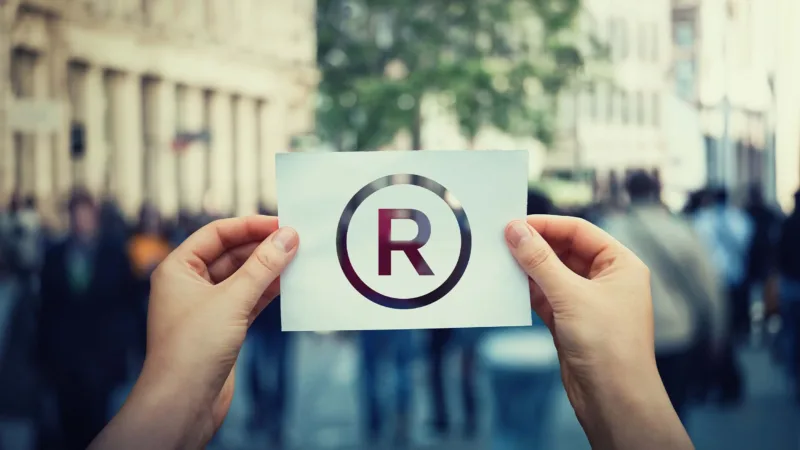A trademark is among the most valuable pieces of intellectual property that a company or individual owns. A trademark is words, symbols, and/or designs defining the owner’s product or service in the public imagination, differentiating it from competitors. If someone infringes upon a trademark, this may threaten the trademark holder’s source of income.
Trademark holders seek to preserve their trademarks against another party’s infringement by cease-and-desist orders or, if such orders aren’t honored by the offender, trademark litigation. They will claim that trademark infringement—the other party’s unauthorized use of a trademark in relation to goods and/or services—stands to diminish and tarnish their own trademark’s value.
An infringed-upon trademark holder will file a civil lawsuit in either state or federal court. Given that much trademark infringement occurs on a regional or national scale, trademark owners file more often in federal court.
Trademark rights
Unlike patent protections, which have a 15- or 20-year lifespan, trademark rights are potentially permanent. That said, a trademark owner must renew their trademark every 10 years, and the trademark must be in commercial use during that period in order to qualify for renewal.
Should the trademark owner fail to renew in time, or if the trademark is no longer considered to be in general use, the United States Patent and Trademark Office (USPTO) may cancel the trademark. Upon cancellation, the owner may reapply for trademark registration. If the trademark isn’t in use at present, the owner must list when the trademark was last used in commerce, when its use will resume, and why the trademark currently isn’t in use.
The trademark owner files a signed statement (“Declaration of Use,” or Section 8) with the USPTO, claiming that their trademark is being used in commerce. The trademark holder provides such information as:
- Goods and services for which the trademark is used; and
- Examples of the trademark in use (such as images of labels attached to goods for sale).
Trademark owners also file a Declaration of Incontestability (Section 15). If the USPTO agrees the trademark is incontestable, various aspects of its registration can’t be challenged by third parties, such as the trademark’s validity.
The statement includes affirmations that there are no pending or ongoing legal proceedings involving ownership of the trademark in the USPTO or in a court of law.
What are the main claims in trademark infringement?
In trademark litigation, a plaintiff typically makes one or both of the following claims concerning the trademark infringement.
1) Likelihood of confusion. The trademark holder argues that the similarity of its trademark and the defendant’s will confuse customers as to who is providing the products or services in question. To establish likelihood of confusion, a trademark holder lists such factors as:
- Proximity of competing trademarks (same geographic region, similar or same types of product/services, same marketing channels used);
- Similarity of competing trademarks, such as a design that suggests the plaintiff’s trademark or a name similar to the plaintiff’s;
- Testimony of consumer confusion (for example, a consumer claiming they purchased a trademark infringer’s product under the assumption they were buying from the trademark holder).
2) Trademark dilution. Here a trademark holder claims that the infringing party’s trademark will diminish the holder’s original trademark.
Plaintiffs argue that a rival, unauthorized trademark, similar in image or name, reduces their trademark’s distinctiveness and thus dilutes its value to the trademark holder. If the infringer uses a similar trademark for a controversial purpose (such as in an adult-themed business), the plaintiff may argue such usage tarnishes the value of the original trademark by associating it in the public eye with controversial or undesirable activities.
What happens if you infringe a trademark?
If the trademark owner proves infringement in court, remedies include the following:
- An injunction preventing the defendant from using the trademark in the future;
- An order requiring the destruction or forfeiture of defendant’s infringing products;
- Monetary relief, including any profits the defendant made on the infringed products/services, to compensate business losses for the plaintiff.
How much does it cost to litigate a trademark?
Trademark infringement lawsuits that advance to trial are estimated to cost between $375,000 to $2 million per case.
What is the trademark prosecution process like?
While trademark infringement proceedings vary from jurisdiction to jurisdiction, litigation typically takes at least a year, and often longer. Cases can be expedited if the plaintiff convinces a judge that the situation mandates it—claiming that a trademark infringement threatens an upcoming product rollout, for example.
To support a trademark infringement claim in court, a plaintiff must prove:
- It owns the trademark in question. Typically it cites the trademark’s listing on the USPTO’s Principal Register, which gives it the legal presumption of validity and ownership of the trademark, and the exclusive right to use it nationwide in connection with goods or services listed in the registration.
- It has priority: that its trademark pre-dates the defendant’s trademark, which also may be registered with the USPTO.
Further, the trademark owner isn’t the only party who can sue an infringer. Parties with exclusive and non-exclusive licenses to sell or distribute a trademarked product/service can also file a lawsuit. To have standing to sue, the person or entity must show a cognizable interest in the trademark infringement.
Plaintiffs will sue for:
- Primary (or direct) infringement, claiming the defendant is using without their consent, in commerce, a reproduction, variation, imitation or copy of a registered mark in a way likely to confuse, and possibly deceive.
- Secondary infringement, claiming the defendant has induced another party to infringe upon the trademark, or contributed to the infringement in some manner.
A defendant may counter these claims with various strategies in court, including:
- Challenging the claimed trademark. Defense counsel may petition to cancel the trademark with the USPTO’s Trademark Trial and Appeal Board. They may argue the trademark registration wasn’t valid (such as the trademark not being used in commerce) or that the defendant’s trademark had preceded it.
- Denying the alleged infringement. The defendant argues that its trademark is dissimilar enough from the plaintiff’s that no confusion or dilution will result from it. It may argue that the plaintiff’s trademark lacks sufficient distinction (like a Boston-based grocery store called Boston Grocery).
Much depends on the plaintiff convincing the court that the trademark infringement in question has passed a “likelihood of confusion” test. Confusingly itself, each circuit court has a different set of criteria, ranging from the Second Circuit’s eight Polaroid factors to the Federal Circuit’s 13 DuPont factors.
Despite the number of factors, the criteria is fundamentally similar across circuit courts. A trademark infringement will depend upon, among other factors:
- strength/distinctiveness of plaintiff trademark;
- proximity/competitiveness of plaintiff and defendant’s business;
- comparative quality of plaintiff and defendant’s products;
- evidence that the imitative trademark was adopted in bad faith; and
- sophistication of consumers in relevant markets, and evidence of confusion.
Case studies of trademark litigation
In Starbucks v. Obsidian Group (2016), coffee retailer Starbucks sued for trademark infringement. In 1995, Starbucks trademarked the brand name “Frappuccino” for its blended ice coffee drinks. The name was originally trademarked four years earlier by Boston’s Coffee Connection; however, Starbucks acquired the trademark upon buying Coffee Connection.
In the mid-2010s, Obsidian (which operates under the name Coffee Culture) began offering the “Freddoccino,” a blended ice coffee drink. Upon learning this, Starbucks sued for infringement.
Starbucks argued that the trademarks had multiple similarities: both are portmanteaus (two words combined to form a third); both have four syllables, starting with “Fr” and ending in “cino”; both evoke “a European-inspired cold coffee beverage.” Further, Starbucks argued that Obsidian served its drink in similar-sized cups with similar circular logos.
As per its filing, Starbucks claimed “Obsidian’s conduct is diluting the distinctive quality of Starbucks’ famous FRAPPUCCINO® mark and is likely to confuse consumers into believing that Obsidian’s products are affiliated with, or are endorsed or approved by, Starbucks, when in fact they are not.” Starbucks claimed dilution of its Frappuccino trademark and that Obsidian had acted in bad faith. The case is still ongoing.
Similarity of colors
Another case involves the question of whether using a similar color as a competitor entails trademark infringement. In T-Mobile v. Aio Wireless (2014), T–Mobile sued to stop Aio Wireless from using a plum color in promoting its consumer wireless telecommunications services and products.
T-Mobile claimed that all major telecommunications companies employ color as a key part of their marketing campaigns (hence “Verizon red,” “Sprint yellow,” “T–Mobile magenta”). T-Mobile claimed Aio had infringed upon its trademark magenta when it used “a confusingly similar plum color.”
In court, T-Mobile offered expert testimony that telecom companies have a long history of “leveraging” colors for their brands, and that in 2007, T-Mobile had registered the magenta mark on the Supplemental Register and subsequently registered further iterations incorporating the magenta mark with other elements identifying its telecommunications services. It demonstrated a 15-plus-year history of using magenta prominently in its print, in-store, and television promotions.
Further helping T-Mobile’s case was the introduction of emails from Aio (and their parent company AT&T) executives which both acknowledged their strategic intention was to court T-Mobile customers while admitting that two brand colors could be too similar.
Finding that “T–Mobile magenta has acquired secondary meaning in the marketplace” and that Aio’s “use of…its plum color will likely cause confusion between Aio and T–Mobile and that the loss of goodwill and potential customers poses a substantial threat of irreparable injury to T–Mobile,” the court ruled that Aio was barred from using the plum color in advertisements, websites, and stores in its marketing campaign and that it must destroy any previous advertisements/promotions using the plum color.
Overlaps in intellectual property
Trademarks are one segment of a broader category of intellectual property (IP). The other main segments of IP are patents, trade secrets, and copyrights.
There are several distinct differences between IP categories. Length of protection is a key one: Patents have a two-decade lifespan, copyrights extend to the life of the creator plus 70 years, and as seen above, trademarks are potentially eternal depending on renewals, as are trade secrets (until the owner divulges the information publicly).
Trademarks also differ from patents in intention. Trademarks are meant to protect names, designs, and images used to distinguish the holder in the public marketplace. Patents, by contrast, may not ever be used in a product for sale—they are meant to protect the holder’s invention from others’ infringement.
There can be overlap in litigation. In the case of T-Mobile above, if the company found that a competitor had violated its patent for a particular type of telecom device and was also using a similar color or logo in promoting it, T-Mobile would likely consider suing for both patent and trademark infringement.
How to handle trademark litigation for your firm
Trademark litigation may be considered a niche area of practice, but it’s an essential one. A company’s reputation and health in the public market can depend upon the distinctiveness and prominence of its products’ trademarks. Trademark infringement is a direct threat to this, and companies often fight aggressively in court to defend their trademarks.
That said, there are ways to make the process more cost-efficient and less complex. The use of technology can improve a plaintiff’s research, speed up discovery, and enable attorneys to craft a more compelling and thorough argument in court. A service like Practical Law is an all-in-one tool with practicing attorney-editors offering expert guidance to help you through a trademark litigation case.







